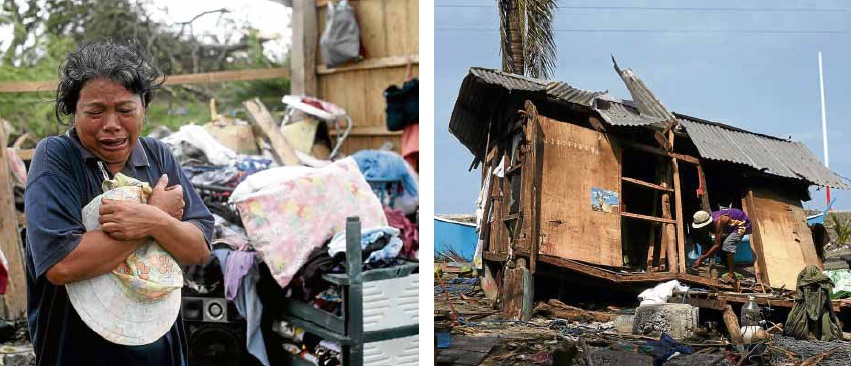
LOST HOMES Feida Pablo (left photo) weeps after Typhoon “Ompong” destroyed her house at Barangay San Pedro, Lasam, Cagayan. In Ilocos Norte, Warly Aguillan (right photo) looks for useable things among the ruins of his house at Sitio Bagac, Pagudpud, Ilocos Norte. —PHOTOS BY RICHARD A. REYES
BAGGAO, Cagayan — The local governments of Cagayan and Ilocos Norte have declared a state of calamity after the two provinces suffered heavy beating from Typhoon “Ompong” (international name: Mangkhut).
As of 3 p.m. on Monday, the Philippine National Police reported 66 dead, 63 injured and 52 missing.
Damage to crops, fisheries and livestock in Cagayan was estimated at P4.6 billion, according to Gov. Manuel Mamba.
The declaration of a state of calamity in Cagayan came a day after provincial officials led by Vice Gov. Melvin Vargas Jr., members of the provincial board and some municipal officials came under fire for going on a tour of Malacañang, a day before Ompong struck.
Vargas said the declaration would allow the use of P98 million in calamity fund for the province.
Hardly recovering from the weeklong monsoon rains, Ilocos Norte province would now need to deal with crop and infrastructure damage worth P3.2 billion.
At a special session of the provincial board in Laoag City, Board Member Ma. Christina Fariñas said her father, Ilocos Norte Rep. Rodolfo Fariñas, was taken to the provincial hospital at 3 a.m. on Saturday after he was hit in the leg by a shard from shattered glass window.
Imee’s troubles with COA
On Sunday night, President Rodrigo Duterte directed local officials to defy the Commission on Audit (COA) circulars after Ilocos Norte Gov. Imee Marcos’ complaints about the COA.
Presidential spokesperson Harry Roque explained on Monday that the President only wanted funds for disaster victims to be released faster.
The President made the testy remarks against the COA in a situation briefing on the effects of Ompong in Laoag.
During the briefing, Marcos repeatedly complained to the President of her troubles with the audit body, particularly in getting cash advances and loans for disaster response.
The governor reported to the President that the COA was not allowing cash advances for the purchase of building materials such as GI sheets.
To this, the President said he wanted to push state audit officials “down the stairs” for their audit observation memorandums issued to Marcos.
Contingency funds
Roque assured the public that Malacañang still had P15 billion in contingency funds, which may be used to augment the relief assistance for disaster-hit provinces this year.
Damage to agriculture in Ilocos Norte was placed at P1.88 billion and to infrastructure, P1.37 billion.
Ompong also killed livestock worth P78 million and destroyed high-value crops worth P25 million.
The typhoon also left 19 public elementary and high schools with blown-off roofs and broken windows that cost the government P12.6 million.
In Isabela province, residents have been reeling from steep prices of vegetables and rice from Benguet and Nueva Vizcaya provinces, which were pummeled by the typhoon.
Cabbage grown in Benguet sold for P200 a kilo while carrots sold for P160 a kilo.
Ginger, garlic and onions, which sold for P70 to P90 a kilo last week, were now being sold for P90 to P120 a kilo.
Classes suspended
Ilagan City and the rest of northern Isabela suspended classes on Monday to allow work crews to remove fallen trees and other storm debris, and to repair classrooms and facilities.
In Pangasinan province, 113 villages in 10 towns and cities were flooded due to swollen rivers, despite the good weather on Monday.
The floods prompted officials to suspend classes in many parts of the province.
The affected areas are along the Agno and Sinocalan rivers. These are the towns of Urbiztondo, Bautista, Bugallon, Bayambang, Mangatarem, Malasiqui, Santa Barbara and Calasiao and the cities of Dagupan and San Carlos.
Major streets in Dagupan were submerged in floodwaters, making them impassable to light vehicles.
A section of the Calasiao-San Carlos road was also impassable to light vehicles, forcing commuters to ride on hand tractor-drawn trailers.
Power restoration
Typhoon-hit communities can expect to spend the next full week with inefficient power as full restoration is expected to be completed on Sept. 24, according to National Grid Corp. of the Philippines (NGCP).
Power was starting to be restored in some areas of Cagayan, which are not supplied by the downed main lines of NGCP.
It would take about a month for power to be fully restored in the province, said Tito Lingan, general manager of the Cagayan Electric Cooperative 1, which covers areas on the southern half of the province.
“For areas with relatively slight damage, power is gradually starting be put back; for lines in other areas like Baggao, which really fell flat,” it may take a lot longer, many about a month,” he said.
Restoration of power lines will be done with help from crews from other electric cooperatives, according to Blandy Madamba, Cagelco II general manager. —With reports from Leilanie Adriano, Villamor Visaya Jr., Yolanda Sotelo and Gabriel Cardinoza in Northern Luzon, and Julie M. Aurelio, Jaymee T. Gamil And Ronnel W. Domingo in Manila

